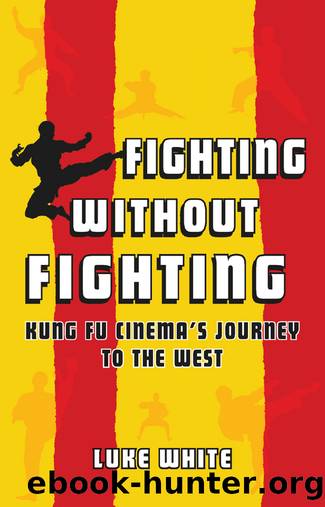Fighting without Fighting by Luke White

Author:Luke White
Language: eng
Format: epub
Publisher: Reaktion Books
Posing with butterfly swords in the video for the Wu-Tang Clanâs âDa Mystery of Chessboxinââ.
RZAâS use of kung fu narratives, however, extended beyond the confines of the lyrics themselves (or even the videos that accompany the work) and became a metaphor through which the groupâs very business strategy and mode of organization were developed. The figure of the âclanâ â and in particular that of the Wudang swordsmen depicted in the film Shaolin and Wu Tang (1983) â became the basis for this. It foregrounded an ideal of loyalty and collectiveness antithetical to the individualism of the world of rap music at the time and combined this with an embattled âus against the worldâ mentality that marks all of their work. This collectiveness had an artistic function, producing tracks where a range of contrasting voices and styles rapidly gave way to each other, and this variety became one of the things that made them musically distinct from their competitors. It also had a business function, with RZA initiating a âfive-year planâ for the group, which sought to launch individual careers while maintaining a commitment to the greater whole where individual earnings were ploughed into the shared project and vice versa. Individual image was subordinated to the creation of an overall brand, which was monetized in forms as diverse as Playstation games and the Wu Wear clothing line.
There are other ways in which rap has plumbed the history of Black American cultureâs fascination with kung fu. One of the most visible examples of an articulation of the martial artsâ connection to radical Black histories is in the âconsciousâ rap of the duo Dead Prez, comprised of Khnum Muata Ibomu and Mutulu Olugbala (who perform under the names stic.man and M-1). In their lyrics, Dead Prez draw together revolutionary Black nationalism, pan-Africanism and socialist anti-imperialism. In word and image they weave an iconography that evokes the Black Power movement of the 1960s. As a part of this, we see coordinated displays of martial artistry in their videos (such as that for their biggest hit, âHip Hopâ, 2000), evocative of the paramilitary drilling of the Black Panthers. The martial arts, however, perform an extended role within their work. They are repeatedly referenced within their lyrics, often becoming the central topic of a song, such as in âWay of Lifeâ, a hymn to the discipline of martial arts training. At other moments, this image of discipline is used to articulate a militant attitude. In âWalk Like a Warriorâ, the mystique of the martial arts and their âjourneyâ is retooled as a metaphor for the transformation from acquisitive gangsterism to conscious revolution. But the associations between the militant and the martial arts run in both directions, offering a radical glamour to practices of individual physical training, which can now be imagined as in themselves emancipatory in nature. This training takes its place within a broader concern in their music to evangelize wholesome living and diet, abstinence from alcohol and even veganism (for example, in the song âBe Healthyâ).
Download
This site does not store any files on its server. We only index and link to content provided by other sites. Please contact the content providers to delete copyright contents if any and email us, we'll remove relevant links or contents immediately.
Shoe Dog by Phil Knight(4183)
The Rules Do Not Apply by Ariel Levy(3914)
Walking by Henry David Thoreau(3237)
Running Barefoot by Amy Harmon(3063)
How to Read Water: Clues and Patterns from Puddles to the Sea (Natural Navigation) by Tristan Gooley(2874)
Crazy Is My Superpower by A.J. Mendez Brooks(2866)
I'll Give You the Sun by Jandy Nelson(2847)
How to Read Nature by Tristan Gooley(2668)
How Music Works by David Byrne(2535)
The Boy, the Mole, the Fox and the Horse by Charlie Mackesy(2461)
Seducing Cinderella by Gina L. Maxwell(2238)
Cuba by Lonely Planet(2191)
The Fight by Norman Mailer(2160)
Going Long by Editors of Runner's World(1925)
Accepted by Pat Patterson(1919)
The Unfettered Mind: Writings from a Zen Master to a Master Swordsman by Takuan Soho(1864)
The Happy Runner by David Roche(1829)
Backpacker the Complete Guide to Backpacking by Backpacker Magazine(1821)
Trail Magic by Trevelyan Quest Edwards & Hazel Edwards(1763)
